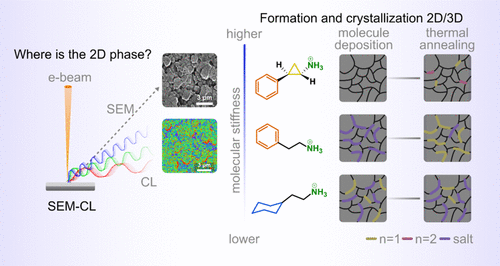Published Paper: 2D Phase Formation on 3D Perovskite: Insights from Molecular Stiffness
LNES > Blog > Publications > Published Paper: 2D Phase Formation on 3D Perovskite: Insights from Molecular Stiffness

- 23 de September de 2024
- LikeUnlikeLike
New Publication in ACS Applied Materials & Interfaces!
We are excited to announce the publication of our latest research paper in ACS Applied Materials & Interfaces, titled:
“2D Phase Formation on 3D Perovskite: Insights from Molecular Stiffness”
This study investigates the relationship between molecular stiffness and the formation of two-dimensional (2D) phases on three-dimensional (3D) perovskite films, offering valuable insights into enhancing both efficiency and stability in perovskite solar cells.
Key Highlights:
- 2D Phase Formation on Grain Boundaries: Using cathodoluminescence in scanning electron microscopy, we identified that the 2D phase forms predominantly on the grain boundaries of the 3D perovskite. This phenomenon offers an explanation for the passivation mechanisms that improve 3D perovskite film performance.
- Molecular Stiffness and Steric Hindrance: Through in situ grazing-incidence wide-angle X-ray scattering, we explored the role of organic cations with varying stiffness. The formation and crystallization of the 2D phase were found to be influenced by both steric hindrance around the ammonium group and the molecular rigidity of the cations.
- Efficiency Boost: Solar cells incorporating flexible cations in the 2D/3D perovskite heterointerface achieved a power conversion efficiency of 21.5%, underscoring the practical importance of molecular design in optimizing device performance.
This research enhances our understanding of the critical factors that govern the interaction between low-dimensional and 3D perovskites and their impact on solar cell efficiency.
You can read the full paper here.
Stay tuned for more updates from our group!
Share:
Search
Recent Posts…
Prof. Ana Flávia Nogueira Featured Among Women Leaders in Clean Energy Research
11 de April de 2025Group’s Participation in the XXII B-MRS Meeting
28 de October de 2024



